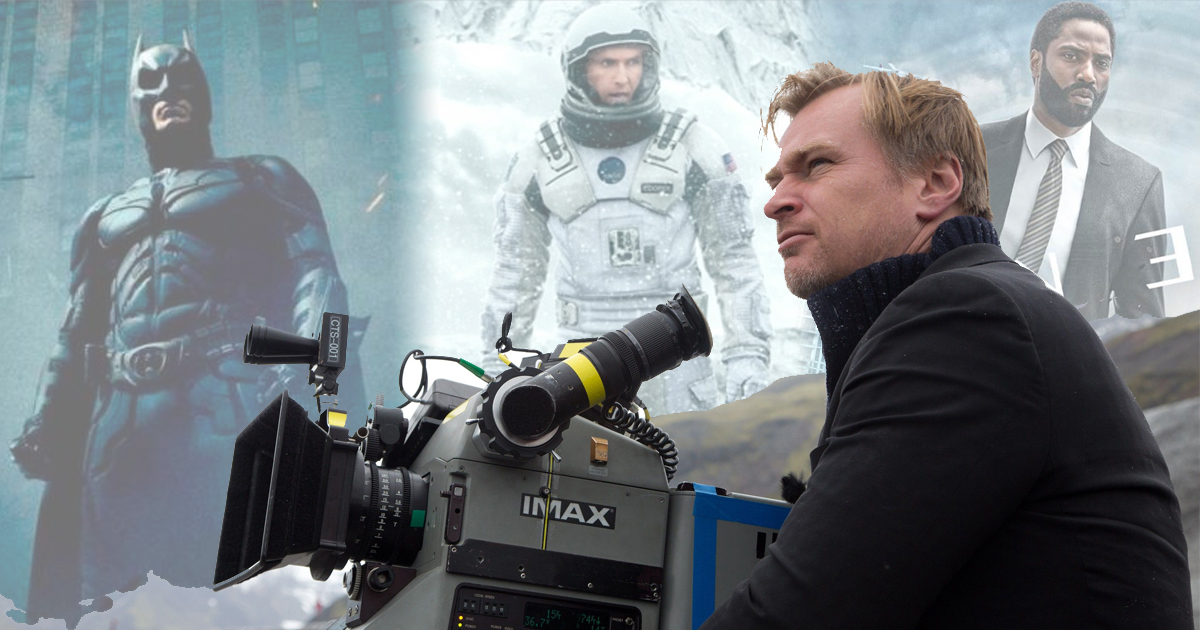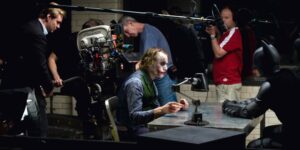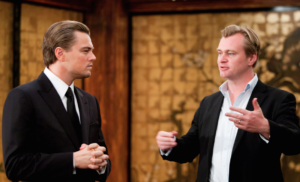
With many, many auteur directors in the past, the path is similar. They start with humble but ambitious human stories that captivate and expand our minds and hearts in ways we never thought possible. Then, they get big money and big actors, and phrases like “final approval” thrown at them. They start making giant awesome tentpole films that people flock to. At some point, they begin wearing an ascot, smoking long thin French cigarettes, talking with a mid-Atlantic accent, “dahling”, and going through wives and Ferraris like disposable COVID masks. Eventually, they become nothing but a giant bloated ego that now makes sad attempts at reclaiming their glory, riding old achievements downhill until they eventually disappear from the limelight and end up as occasional cover pieces on Weekly World News, in the grocery checkout line. Is Christopher Nolan any different? Well, some people seem to think his choices in sound design might lead to yes, including his newest highly anticipated Tenet. I’m not so sure.

Christopher Edward Nolan. The name alone will spark memories of some of the most wonderstruck and exciting films of the last 10-20 years. My first encounter with anything Nolan was as a set P.A. on the Dreamworks film “The Time Machine” in early 2001. Memento had just hit theaters, and I was having lunch 2 tables down from Guy Pearce himself! It was a young filmmaker’s dream, and so was that awesome little indie film, Memento. Since then, Nolan’s films have gotten a lot bigger. A whole lot bigger. Within this arena comes lots of rewards for the filmmaker, not only through accolades, but through power, and something called creative control. When 30-year-old Nolan was making Memento, he was “in charge,” unless one of the financiers wanted their niece in a role, or if a location was too expensive, or the producers didn’t want to pay the rental house for that one piece of kit for a special shot he wanted. So really not entirely in charge. As his films ballooned in profits and awards worldwide, the training wheels were off, and Nolan began making giant epic films, Tenet being no exception. Screen Radar reader BK asked me to weigh in on Twitter:
@screenradar @FilmSnork I haven’t seen it yet, but since you guys have an expert on your team, interested in your thoughts. https://t.co/ApAYyPBtub
— BK (@BKforReal) September 1, 2020
So here’s what I got.
The first couple of audio flags on the Nolan filmography came from the use of the Batman growl. A few people complained it made Batman hard to understand, while some thought it was cool, and an effective tactic to use for a vigilante to further intimidate his targets. The next one came in the use of the Bane voice, which was a combination of Tom Hardy’s accented performance and filtering added to make it sound like the mask was somehow amplifying Bane’s voice. The resulting tinny, warbled, but distinct voice again bothered some, but more as a point of humor than anything else. It just seemed funny to people that a menacing baddie like Bane would have such a comically weak and weird voice. No big deal. However, since the Dark Knight films were a huge success all around, and pretty universally loved.
My next brush with the Nolan-verse was much more substantial and cathartic for me. In 2014, two films were out that I was really excited about- Whiplash, which I mixed, and Interstellar, which just looked to be the biggest and best thing we could look forward to that year. When news reports started cropping up suggesting some sound issues with Interstellar, it didn’t make much of a splash in the headlines. That was until movie theaters started posting signs outside saying that the sound in the film is as it is supposed to be and that there was not anything wrong with the theater’s own sound systems. This means that enough people were complaining, and more importantly, wanting refunds because the sound was so disrupting that they did not enjoy the film. Uh oh. Does this mean that there is something that was done wrong here?
Interstellar still went on to make a ton of money, and get nominated for and win piles of awards. It was nominated for best sound mixing in the 2015 Academy Awards alongside American Sniper, Birdman, Unbroken and Whiplash. Yes, the $3.5 million indie that I mixed was nominated for an Oscar alongside the $165M juggernaut I had enthusiastically watched and loved just 6 months before. Now, I had no idea I would eventually win, but the idea of being in competition with four films whose catering budgets were bigger than Whiplash’s in its entirety was daunting, and I had all but convinced myself that our tiny little film had no chances of getting Oscar Gold. Whiplash did win though, amazingly. After winning, of course, things changed a lot for me, and a lot of people had passed murmurings my way to the likes of “We could actually hear what was going on in Whiplash” and it had me reeling on how powerful this whole sound thing can be. I had to ask myself ‘Did I win an Oscar because Christopher Nolan screwed up?’
Across the history of films, sound has been the somewhat unloved stepchild of the film industry. The second film that Edison ever shot had sync sound, but the contraption was so cumbersome that they abandoned it as impractical. Yet when the cinemas took off as a new form of entertainment, they quickly saw the need for some sound, which came in the form of live piano players in the theaters. They knew even 120 years ago that sound had an intrinsic connection to the emotional impact of a film. Sergei Eisenstein’s montage experiments proved that editing can affect the perceived emotions of an actor on screen, and further enhanced as more information becomes available. As sync sound developed, it was initially used more as a conveyor of information, and a sort of blunt force form of telling the audience who the characters were through heavy-handed score progressions. They bent over backward to accommodate sound, and it got a reputation as a nuisance. Noisy cameras had to be blimped in huge awkward contraptions to keep them from ruining the sound, stages had to be reinforced and soundproofed to accommodate sound, and tons more effort and money were put into improving the quality of the sound overall. The studios’ expenses were rewarded with more consistent product results since they didn’t depend on the pianists’ personal repertoire or each individual theater, and a more immersive experience for the audience as a whole.

Through the next 80 years, cinematic sound design would continue to grow, and be seen by some as another shade on the creative pallet, and a necessary evil by producers. In the studio film mayday through the end of the ’80s, film sound was a very complex endeavor that was expensive, laborious, time-consuming and fraught with all kinds of difficulty. Getting good sound recorded and mixing it all into a great sounding final product took much longer, cost much more and used many many more people then than it does now. As the tech improved, the abilities it gave the filmmakers also improved, and made them easier and less expensive to wield, so as the 80s, 90s and 00s progressed, we see more and more creative use of sound design. Some good, some bad, depending on your point of view.
As TV and radio employed ever more crushing levels of compression on their soundtracks, people noticed that it was easier to understand the words on average. People have become used to this trend, and have come to expect a very crisp and present dialog track. It’s an expectation of the audience that if you’re telling a story, they should be able to hear it as effortlessly as they watch it. It has become a symbiotic relationship that comprehension of the picture overall depends on comprehension of the sound. Comprehension of the dialog specifically is one way of storytelling, the actual telling part, but sound holds a lot of the emotional content of the film as well.
Throughout cinematic history, sound or the lack of sound can be used to manipulate the audience, telling them how to feel before they even know what they are seeing. The sense of hearing is hard-wired into our brains as a survival mechanism, so it is a direct path to our fight or flight instincts, and as such, can manipulate us as an audience in some really visceral ways. We see a lot of this in Whiplash as well as Interstellar, but there is another layer on top of this that Nolan seems to have latched onto, and it counters the trends of the last 30 years.
Nolan has been doted upon by filmmakers for his use of practical effects, making huge efforts to use real things on real sets for the actors to interact with, and also for a feeling of realness in the final product that the audience can perceive. When it comes to sound, the trend has been to lose ambient sound in favor of kicking up the dialogue. If you watch films like The French Connection or Midnight Cowboy, or some early Woody Allen films, or almost any of Robert Altman’s films from the 1970s. they had broken out of the film studios and were using a lot of location sound, a lot of ambient sound, and overlapping dialogue. It created a more verite and alive feel than the boxy studio films of the 60s. There was life, grit, messiness. Dogs barking, sirens, horns, cars, radios, footsteps galore, a cavalcade of… noise. The trend slid away from this towards the clean crisp sound of most movies now, where sound design is employed with surgical precision and subtlety. The tech has allowed so much of this to happen that we are now exploring going back to noise, but now it’s clean noise. The use of heavy ambiance in cinema is a creative tool, a trend, and something that can be used by a director to all his or her story the same way that shaker-cam techniques have been used or overused on the visual side.
Disrupting the expectation of the viewer is a way to impart a sense of dread, or feeling that control has been lost. It adds a sense of chaos, fear, and an inability to predict what might come next. To further this effect, when someone feels like they are missing details, they get drawn into the story further, as the brain wants to understand things, so it will redouble its efforts when it is being confused. These are the cinematic muscles Nolan has been flexing lately. With his ever encompassing mastery of the media, he is intentionally making some scenes harder to understand through the use of ambiance. It is not only a storytelling tool but another practicality experiment as well. Here’s why- In your everyday life, most of the time there is some noise going on around you. Close your eyes and just listen for a while. Try to think and focus on each individual thing you can hear, from birds to a distant construction crew to the fridge in the next room quietly humming away. On any given day our brains tune out a very large percentage of unimportant ambient sounds, especially ones we are exposed to regularly. When you are in a very noisy environment, it is hard to comprehend people talking to you, and this can be frustrating and can really make time-sensitive or detail-oriented tasks more difficult when you need to focus or need to communicate effectively. Add this to a film, and you’ve added one more layer of challenges for the character to overcome and boom, made the scene have another layer to build on. This can be seen and heard in Interstellar’s use of the corn hitting the truck body when they are driving through the fields chasing the drone. It can also be seen with the rumbling droning sound of the ship, and all kinds of atmospheric effects during the water planet and in the tesseract bookcase. The louder the ambiance, the more tense these scenes become.
So one might think “where does the blame lie here?” And that is a hard question to answer as well. Nolan chose to do this. It’s not an accident, it’s not that he can’t hear well, or that he has somehow hired hack sound designers. No, this is done on purpose, with intent. So that’s that then, right? He’s an idiot who doesn’t respect his audience enough to give them an easily digestible soundtrack. Well, not really, yes and no. You see, the ability for a master storyteller to confound his audience is nothing new. Doing it with sound is kind of new, however, and this is where the rub lies. As a more visual medium, the cinema has experimented with visual effects and metaphors for over a century, while sound has been much more utilitarian and direct in its employment in theatrical mainstream film. While this doesn’t mean that no-one has played with sound, it’s more that it is less acceptable to the audience as pleasing, but hey, it’s art, right? Art should challenge the audience, right?
When you add in the fact that this is also a business, and that the film itself is a product made for consumption and made as a profit vehicle, then you’re looking at a whole other side to this. A company wants to put out products that are easy for anyone to consume. The more people that enjoy a product, the more money they make, so the easier it is for everyone to enjoy it, the easier it is to make tons of money quickly. When a studio puts up $165M to make Interstellar, they are also looking at an additional $150-175M of marketing to make sure everyone who might want this product knows how to get it. As a company, they are under a lot of pressure to not only make that money back but a lot more as well. Part of the promise that the studio makes to the audience is that they are selling a product you’re going to want, in a way that is also pleasing to experience. The experience part is really what the theaters are selling now. Better picture, better sound, better experience all around is what you’re paying for. So when one of the parts of the experience becomes a distraction from the consumption of the product, that’s a problem for the manufacturer.

This is where it gets muddy because the studios have given Nolan creative control over the films, it means they have to accept them how they are delivered and take the good with the bad. Studios have been known to manipulate films sometimes heavily after they are made to boost their profit potential. This includes changing music, lines of dialog, even reshooting major parts to get a product that tests higher before they release it. So now that Nolan is putting challenging audio into his films, they are no longer a product that appeals to everyone, and in some cases most people. Is this wrong, or misguided or high brow? It depends on the viewer.
Cinema and art in general are subjective mediums. This means they may affect everyone in ways as unique as each viewer. Of course, the “mainstream” means that things have wide appeal to a broad range of viewers, and so that means in a random sample, a majority will generally enjoy product X. There are always some who will dislike it for broadly individual reasons, but when one aspect of a product gets criticized in the mainstream, there are a couple of ways of looking at it.
Firstly, the common thought is that this was a mistake, or oversight, a missed call that Nolan just doesn’t get. This is hardly true as he has not only repeatedly used heavy ambiance in select scenes since the Dark Knight films, and spends months on the sound design, making everything as he intended it to be heard. There is no way the sound on these films is released with accidentally bad audio.
The second thought is that the director has overestimated the audience’s ability to deal with challenges. This is a possibility, in that Nolan understands these things so deeply that he can’t fathom someone not getting it. Many times people complain that Hollywood treats its audience like idiots, dumbing down complex dialogue, and plot lines so that Joe Lunchbox can follow along. By not delivering on the promises of mainstream cinema, he has let us down by making this a tougher pill to swallow.
My belief system here is that Nolan does do this on purpose, and he does it because he believes in his audience. He makes smart films, with complex plots, complex characters and complex effects. Part of what makes Nolan’s films such a unique experience is that they challenge your brain on multiple fronts. Inception not only bent our minds with the dream in a dream rabbit hole but literally bent reality as well, leaving us wondering about it all the way home. He knows that if he gives you a deep enough story with characters you want to know, and care about how they will come through this journey, that throwing obstacles at you will not sway you from the goal of following the story, but will pull you in deeper.
Ambient sound is inescapable in real life. It is a real factor with stress and anxiety sufferers, and controlling it is a critical aspect of designing the theater experience as we know it. To manipulate ambient sound to a distracting level is something that might put you off, but it is also doing so for the characters you are watching, so it is a common bond, literally making you part of their reality, and giving better insight into the actual experience of the characters. This is an emotional manipulation tool that Nolan wields like the master he is. He is an emotional conductor that is using his orchestra to have his way with your feelings, and his orchestra keeps getting bigger. The error is going into a Christopher Nolan film expecting to be spoon-fed, but that is your right as a consumer. After all, Dogs Playing Poker paintings have made more money than all the Rembrandts ever painted. Chef Boyardee made more money than Gordon Ramsay, and there’s nothing wrong with that.
If you find yourself watching a film, and something doesn’t make sense or puts you off, it’s easiest to say that the filmmaker got it wrong, and huff and puff about how stupid they are. But if you go back and try to analyze and interpret what you are being told and how it is being told without expectation, you might get a whole new deeper dimension to what you are experiencing. What I’m saying is give Chris the benefit of the doubt, and try to find the message in the medium. The reward is yours to take.
-Thomas Curley, CAS


Great article, Tom!
I am 100% percent with you on this.